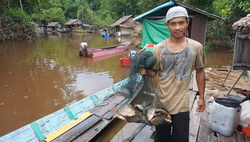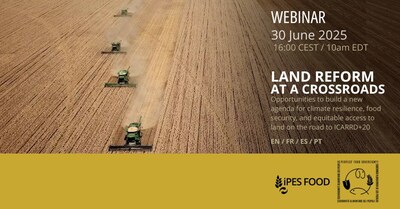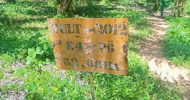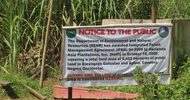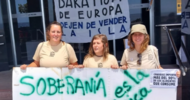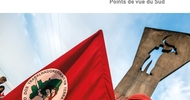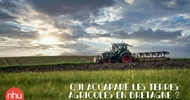Toxic river: the fight to reclaim water from oil palm plantations in Indonesia [Bahasa Indonesia]
As the world continues to battle a pandemic, access to clean water has become more important than ever -especially since one of the best ways to protect ourselves against Covid-19 is to regularly wash our hands with clean water. A simple order, yet a potentially difficult one to fulfill, especially among communities increasingly facing water scarcity. People are struggling to access the quantity and quality of water needed for drinking, cooking, bathing, handwashing, and growing food.
The climate crisis has turned water into a valuable commodity, triggering a frenzied rush to control access to this resource – a phenomenon known as water grabbing.
Agriculture is the most important use of freshwater in the world. Production of food and other agricultural commodities account for over 80% of fresh water use.1 Water grabbing linked to land grabbing by agroindustry has led to countless cases of social conflict and environmental destruction around the world. The industry boom in the demand for palm oil as a cheap vegetable oil alternative, is a clear example of this. It has come at the high price of rainforest destruction, labour exploitation, and brutal land and water grabbing.
Squeezing Indonesia dry
Only few countries in the world have experienced the rapid expansion of oil palm plantations like Indonesia. Oil palm is not a native crop to the country, and yet the nature of the tree means that it can only be grown in a narrow band of tropical land North or South of the equator with abundant and evenly spread rainfall. The average water needed during cultivation period is equivalent to 3.4 mm of rainfall per day equal to 34,000 litres per hectare (ha) per day.2 These specific conditions make the potential area for oil palm plantations rather limited, and it is found in Indonesia.
Global production of oil palm is around 72 million tons, and Indonesia alone produces almost 35 million tons annually. The country currently has 14 million hectares of cultivated oil palm plantation and this is expected to grow.3 The government of Indonesia has continued to promote and encourage the expansion of oil palm plantations since the boom in market demand for biofuels in the early 2000s. It plans to expand the area of oil palm plantations to 26 million hectares. What started by one Belgian company who opened up the first commercial oil palm plantation in North Sumatra in 1911, now encroaches almost every island in the country, bringing with it a destructive impact both to the community and environment.
Some of the major plantation companies operating in Indonesia have expanded their business to other parts of the world. Companies like Wilmar International, Cargill, Golden Agri Resources, Socfin Group and Asian Agri are among the plantation owners who have been actively expanding into Africa and Latin America over the past decades. The fact is that land in Indonesia and Malaysia – the two countries who produce almost all of the world’s oil palm – has become too dense for new plantations. It is critical to expose the daily reality and struggle for water of people living around and on oil palm plantations. Local communities are deeply concerned about their freshwater sources. But the long-term impact of oil palm plantations on freshwater streams seems to have been overlooked until now.
In Indonesia, more than 82 million people still experience lack of access to proper water and sanitation.4 And yet, water grabbing by oil palm plantation indicates an advanced stage of water liberalisation. It is no longer just the commodification of water in its visible form, such as the privatisation of piped drinking water or bottled water, that is the only problem. But it’s also about virtual water, which is the amount of water that is used in the production of food and other products. And these amounts are huge. The impacts of this can be categorised in several ways:
-
Mass destruction of upstream water sources due to forest clearing for plantations.
-
Contamination of water sources for residents either by fertilisers, waste processing, or by materials contained in natural resources that are stripped during the extraction process.
-
The drying up of people's water sources due to the high consumption of water by the palm oil industry in each of its production processes.
-
Land clearing for extractive industries like palm plantationshas reduced the soil’s capacity to absorb rainwater and often leads to floods around the plantation area.
-
Water grabbing outside industrial areas because of the increased demand for bottled drinking water in oil palm production areas due to lack of clean water.5
Between 2000 and 2020, the area of oil palm plantations in Kalimantan more than doubled, from 2.4 million ha to 5.8 million ha. West Kalimantan is the third largest area of oil palm production in Indonesia with the plantations covering nearly 1,5 million ha across its eleven districts. The expansion of plantations in West Kalimantan started in the 1980s with the assistance of international financial institutions, like the World Bank group that promoted the nucleus plasma pattern, a type of contract farming, to communities.6;7 The pressure from oil palm plantations has pushed communities in the region on a common struggle to access clean water and continue producing food. But it’s not only the quantity of water that is under threat from the massive expansion of oil palm plantation. Communities in two districts in West Borneo, Ketapang and Sambas district, have also reported water contamination in their river and water source from the heavy use of fertilizer and pesticides inside the plantations.8
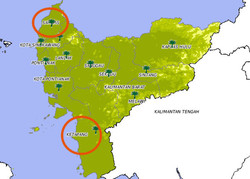
Sambas
In the Semanga village, on the banks of the Sambas River, where the majority of villagers are farmers, rubber tappers and fisherfolks, oil palm is the biggest land user. Around 280 ha of land belong to two oil palm companies: PT. Agro Nusa Investama (ANI), a subsidiary of Wilmar International and PT. Wana Hijau Semesta (WHS), subsidiary of Duta Palma group. Besides these plantations, there are also rice and horticulture fields owned by the villagers.
Oil palm plantation started in the area around 25 years ago, and the fisherfolks have continuously raised concerns regarding water pollution as fish stocks keep dropping every year. According to Asmadi, a 60 year old local fisherman, before oil palm plantations existed in the area, fisherfolk could catch hundreds of kilos of fish, while now they only get four to ten kilos per catch.
Almost every year there are problems with dead fish in the river, especially during the dry season between May and July. These usually start with the river becoming unnaturally bluish green, and the villagers then going to catch the dead fish. People say the fish tastes bitter and sour, and those who eat it often get stomach aches. In a media statement, the head of the Sambas district environmental management bureau said that the dead fish incidents in the Sambas River were due to oil waste from crude palm oil processing that enters the river flow. There has been an investigation to prove whether the company has violated waste disposal rules, breaching environmental standards. So far, however, there has been no verdict or sanctions from the district authority against the company.10
Rice farming under attack
Few villagers continue to work on rice farms, and the majority of them are now women. According to Mardiah, a woman farmer, the deforestation and the heavy use of agrochemicals that come from oil palm production have led to increases in pest attacks on villagers’ rice fields. The rice fields are mainly watered by rainfall with no irrigation, and are located on the river bank. In addition, the rice rations handed out by oil palm companies are undermining the interest to continue farming, and villagers, especially the men, are becoming workforce for the plantation.
There are two water sources for the villagers: spring water from the Senujuh mountain, which is normally used for drinking and cooking, and the Sambas River and its streams, used for washing and bathing.The sustainability of the spring water however, has been threatened by stone mining and therefore communities are now mainly relying on water from the Sambas River. Its streams flow among palm oil plantations before ending up in the Sambas river. An investigation conducted by ECOTON found that there are 8 different fertilisers and 5 pesticides used in the plantation that contain toxic heavy metals that have polluted the river water.11
Although government officials have acknowledged the worsening of the Sambas’ water quality, there is no public information regarding the exact toxic pollutants in the river. Nevertheless the community’s health is evidence of the polluted river. The contamination in one of Sambas’ tributaries, the Sajingan Kecil, caused skin irritation on 142 people.12 ECOTON together with the communities in the Sambas River have been taking samples to identify source and types of pollutants in the river and canals. They found a high level of chloride and phosphate in Sambas’ streams driven by oil palm plantations.
Field observations also found that PT Agro Nusa Investama, a Wilmar subsidiary still uses glyphosate and paraquat to control weeds in the plantations despite the fact that the two herbicides have been banned in many countries due to their toxicity. The Roundtable of Sustainable Palm Oil (RSPO), of which Wilmar is a member, has also banned the use of paraquat in the oil palm plantations of its members. In their sustainability report, Wilmar claimed that they have phased-out the use of paraquat in all their plantations since 2011, but evidence from the ground shows otherwise.13
Ketapang
Simpang Tiga Sembelangaan village in Ketapang, West Kalimantan is surrounded by two plantations owned by PT. Agro Lestari Mandiri, subsidiary of Sinar Mas and PT. Ladang Sawit Mas of the Bumitama Gunajaya Agro (BGA) group. The oil palm plantations, which started operating in the 1990’s, have changed the socio-economic and environment of the village.
Before the plantations, villagers used the Pawan River, which connected the city with 7 subdistricts as their one and only clean water resource. Besides these two oil palm plantations, along the river there are five other oil palm plantations, a settlement and community farms.
After major land clearings and the start of plantation activities, the river became polluted, and village families, accustomed to consuming the river water, started to fall ill. Pushed to find other water sources, villagers build a simple water reservoir and plumbing for their families. In the last ten years, 670 households have been enjoying a clean supply of water from springs by paying a monthly contribution of between USD 0.35 to 0.70. Seventy-five households, however, still depend on the Ladang Sawit Mas plantation for their clean water supply, and another 140 households which didn’t receive water plumbing have had to rely on groundwater.
The disastrous impact of the oil palm plantations on the lives of fisherfolks has been absolute. On the one hand, the plantations’ alteration of the river tributary channel and the decrease of water quality and quantity has rapidly shrunk their catch. On the other hand, besides being fisherfolks, before the coming of the plantation, many were also farmers, nowadays, however, most of them work as labour in the plantation. They thought this could provide a more stable and regular income, but the reality is that the majority of oil palm workers depend on loans to meet even their most basic daily need.
Stop oil palm destruction of water source
More land has been grabbed for oil palm on the tropical island of Kalimantan over the past decades than anywhere else on earth. While it continues to target the customary lands of indigenous peoples, who account for about 40% of the island's population, it is also destroying the surrounding environment, forests, water springs and rivers.
The experiences of the communities in West Kalimantant once again shows the profound impacts of oil palm plantations on local communities. And the cruel irony where communities are forced to become cheap labour for oil palm plantation companies, in land that used to be theirs, after those very same companies destroyed their livelihoods. Their access to land and water resources is lost, now and for future generations.
The surging global demand for oil palm also needs to be understood as water grabbing, and not just for those communities who have lost their land but also for communities living in the surrounding areas because water and rivers cover a wide territory and living space for humans and the environment. It is critical to continue supporting and strengthening communities and their struggles against large-scale industrial plantations. The well-being and future of communities, of the land, water and our climate depend on it.
******
1 UNESCO World Water Assessment Programme, “Facts and figures. About 80% of global virtual water flows relate to agricultural products trade”, accessed 24 November 2020, http://www.unesco.org/new/en/natural-sciences/environment/water/wwap/facts-and-figures/all-facts-wwdr3/fact-25-virtual-water-flows/
2 Herda Sabriyah Dara Kospa, Kris R.D.Lulofs, Chay Asdak, “Estimating water footprint of oil palm production in PTP Mitra Ogan Baturaja, South Sumatra”, International Journal on Advance Science Engineering Information Technology, 2017, https://ris.utwente.nl/ws/files/27682641/2451_9479_1_PB.pdf
3 Info Sawit, “Produksi minyak sawit CPO Indonesia Agustus 2019”, accessed October 2020, https://www.infosawit.com/news/9383/produksi-minyak-sawit--cpo--indonesia-agustus-2019-capai-34-7-juta-ton
4 Central Bureau for Statistics, “Persentase rumah tangga yang memiliki akses terhadap layanan sanitasi layak dan berkelanjutan, menurut provinsi, 2017-2019”, https://www.bps.go.id/indicator/23/1558/1/persentase-rumah-tangga-yang-memiliki-akses-terhadap-layanan-sanitasi-layak-dan-berkelanjutan-40-bawah-menurut-provinsi.html
5 The Institute for Ecosoc Right, “Industri perkebunan sawit dan hak asasi manusia”, 2015, https://www.academia.edu/35282375/INDUSTRI_PERKEBUNAN_SAWIT_DAN_HAK_ASASI_MANUSIA
6 Julia, “Pembangunan untuk Siapa? Implikasi jender perkebunan kelapa sawit terhadap perempuan Dayak Hibun di Kalimantan Barat”, Jurnal Tanah Air, Walhi, Oktober – Desember 2009.
7 A term which derives from the state-promoted ‘nucleus estate’ plantation model introduced in the 1980s, under which smallholders (‘plasma’) would be under contract with the large company (‘nucleus’) to produce oil palm.
8 Based on ECOTON and community organisers’ study on activity and livelihood in the two districts.
9 Informasi Kelapa Sawit, “Potensi kelapa sawit di Kalimantan Barat”, 2012, http://informasi-kelapasawit.blogspot.com/2012/11/potensi-kelapa-sawit-di-kalimantan-barat.html
10 Kalbar Kabardaerah, “Diduga terindikasi tercemar limbah CPO, ikan di Sungai Sambas mendadak mati”, 31 July 2019, https://kalbar.kabardaerah.com/2019/07/31/diduga-terindikasi-tercemar-limbah-cpo-ikan-di-sungai-sambas-mendadak-mati-%E2%80%8E/
11 ECOTON compiled the list of agrochemicals used in two plantations PT ANI (Wilmar International) and PT LSM-BGA.
12 Pontianak Tribun News, “Sungai tercemar 142 warga dusun Sajingan Kecil terserang penyakit kulit”, October 2016, https://pontianak.tribunnews.com/2016/10/17/sungai-tercemar-142-warga-dusun-sajingan-kecil-terserang-penyakit-kulit
13 Wilmar Sustainability Report 2013, “Transformation through engagement”, 2013. https://www.wilmar-international.com/sustainability/wp-content/themes/wilmar/sustainability/assets/Wilmar%20Sustainability%20Report%202013%20-%20Final%20(low-res).pdf


